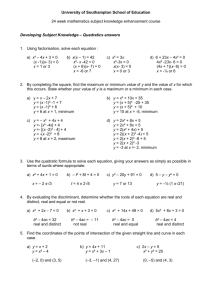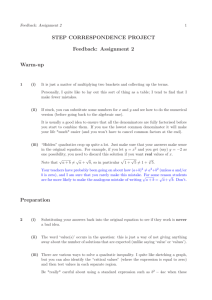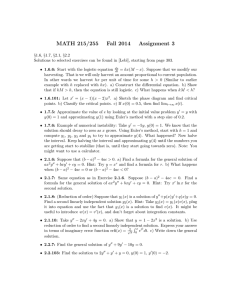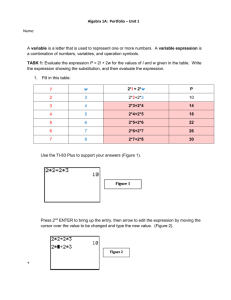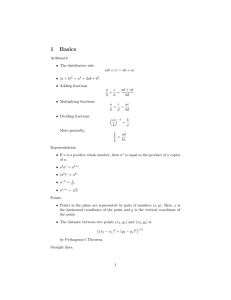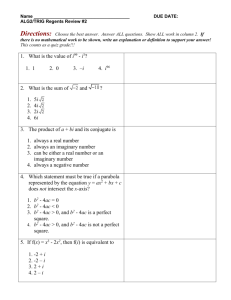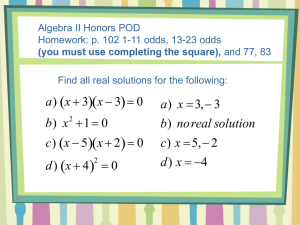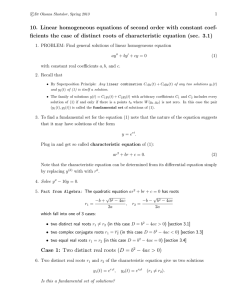Math 414 Professor Lieberman February 18, 2003 HOMEWORK #4 SOLUTIONS
advertisement
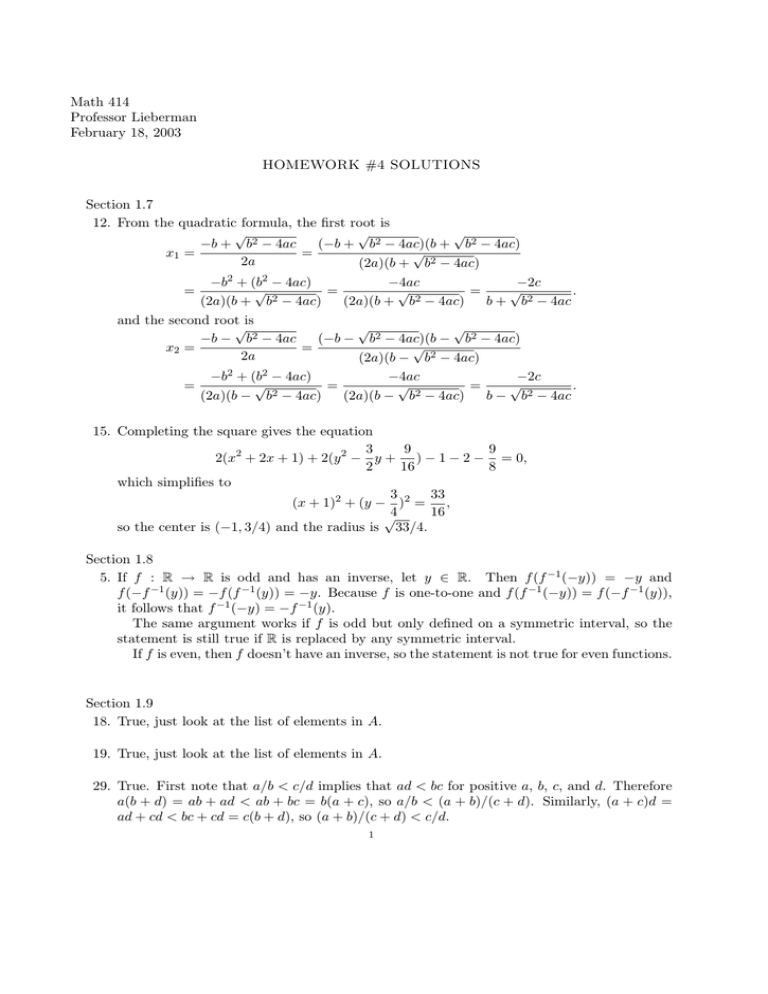
Math 414 Professor Lieberman February 18, 2003 HOMEWORK #4 SOLUTIONS Section 1.7 12. From the quadratic formula, the first root is √ √ √ −b + b2 − 4ac (−b + b2 − 4ac)(b + b2 − 4ac) √ x1 = = 2a (2a)(b + b2 − 4ac) −b2 + (b2 − 4ac) −4ac −2c √ √ √ = = . 2 2 (2a)(b + b − 4ac) (2a)(b + b − 4ac) b + b2 − 4ac and the second root is √ √ √ −b − b2 − 4ac (−b − b2 − 4ac)(b − b2 − 4ac) √ x2 = = 2a (2a)(b − b2 − 4ac) −b2 + (b2 − 4ac) −4ac −2c √ √ √ = = = . 2 2 (2a)(b − b − 4ac) (2a)(b − b − 4ac) b − b2 − 4ac = 15. Completing the square gives the equation 3 9 9 2(x2 + 2x + 1) + 2(y 2 − y + ) − 1 − 2 − = 0, 2 16 8 which simplifies to 3 33 (x + 1)2 + (y − )2 = , 16 √4 so the center is (−1, 3/4) and the radius is 33/4. Section 1.8 5. If f : R → R is odd and has an inverse, let y ∈ R. Then f (f −1 (−y)) = −y and f (−f −1 (y)) = −f (f −1 (y)) = −y. Because f is one-to-one and f (f −1 (−y)) = f (−f −1 (y)), it follows that f −1 (−y) = −f −1 (y). The same argument works if f is odd but only defined on a symmetric interval, so the statement is still true if R is replaced by any symmetric interval. If f is even, then f doesn’t have an inverse, so the statement is not true for even functions. Section 1.9 18. True, just look at the list of elements in A. 19. True, just look at the list of elements in A. 29. True. First note that a/b < c/d implies that ad < bc for positive a, b, c, and d. Therefore a(b + d) = ab + ad < ab + bc = b(a + c), so a/b < (a + b)/(c + d). Similarly, (a + c)d = ad + cd < bc + cd = c(b + d), so (a + b)/(c + d) < c/d. 1 2 53. True, we use a contradiction argument. Let A be the set of algebraic numbers, and let T be the set of transcendental numbers. We know that A is countable by Exercise 52, so if T were countable, then Theorem 1.4.5(c) would say that R = A ∪ T is also countable, which contradicts Theorem 1.4.5(f). Section 2.1 3. (a) From Example 1.3.3, we have 1 1 n(n + 1)/2 = + . 2 n 2 2n Therefore limn→∞ an = 1/2. (A complete proof of this fact is not needed here.) (b) Now we use Exercise 2(b) from Section 1.3 to conclude that n(n + 1)(2n + 1)/6 1 1 1 an = = 1+ 2+ , n3 6 n n an = so limn→∞ an = 1/3. 4. If (an ) converges to zero, then for any ε > 0, there is a number n∗ ∈ N such that |an −0| < ε for all n ≥ n∗ . For this same n∗ , if n ≥ n∗ , then ||an | − 0| = |an | = |an − 0| < ε, so also (|an |) converges to zero. If (|an |) converges to zero, then for any ε > 0, there is a number n∗ ∈ N such that ||an | − 0| < ε for all n ≥ n∗ . For this same n∗ , if n ≥ n∗ , then |an − 0| = |an | = ||an | − 0| < ε, so also (an ) converges to zero. 5. Let ε > 0 be given. Then there is a number n∗ ∈ N such that |an − A| < ε for all n ≥ n∗ . If n ≥ n∗ , then Exercise 6(b) from Section 1.7 gives ||an | − |A|| ≤ |an − A| < ε, so (|an |) converges to A. The converse is not true. To see this, we need to give a sequence (an ) and a number A such that (|an |) converges to |A| but (an ) does not converge to A. There are lots of examples: an = (−1)n and A = 1 or an = −1 and A = 1. This problem differs from the previous problem because A is nonzero.
